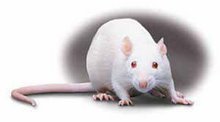http://news.yahoo.com/s/ap/20070425/ap_on_sc/habitable_planet
http://www.physorg.com/news96694571.html
 Image from the PhysOrg.com article: Artist's impression of the system of three planets surrounding the red dwarf Gliese 581. One of them is the first rocky planet lying in the habitable zone to have been discovered. Credit: ESO
Image from the PhysOrg.com article: Artist's impression of the system of three planets surrounding the red dwarf Gliese 581. One of them is the first rocky planet lying in the habitable zone to have been discovered. Credit: ESOBy “Earth-like” they mean that it is relatively similar in size (it is 1.5x larger, which is relatively the same compared to all the gas giants they’ve found so far) and is of a temperature that could support water. The planet orbits a dwarf red star, called Gliese 581, and though it is closer to its star, the average temperature could range between 0 and 40 degrees Celsius. It rotates its star every 13 days, and is the third planet found in that solar system (the other two are much more massive, and most likely gas giants like Jupiter), and thus the planet is known as “581c” or simply “C”. It’s also a relatively close 20.5 light years away from us. “C” is the first out of 220 planets found so far which is of the right size, temperature, and likely composition to support Earthlings.
From the PhysOrg article: "Liquid water is critical to life as we know it," avows Xavier Delfosse, a member of the team from Grenoble University (France). "Because of its temperature and relative proximity, this planet will most probably be a very important target of the future space missions dedicated to the search for extra-terrestrial life. On the treasure map of the Universe, one would be tempted to mark this planet with an X."
Nifty. Of course, there’s a lot still unknown. It COULD support water, but does it? They don’t know. And they don’t know if there is even an atmosphere of any sort. But it does fire the imagination, doesn’t it. Just think, because it is so close to its star, the red dwarf star hangs like a giant red sphere over the horizon, 20-times larger than the moon appears to us on Earth. And whether the temperature is a water-freezing 0 degrees Celcius, or a balmy-jungle 40 degrees, it would still be habitable for us humans as long as the atmosphere was right.
Anyone got a rocket ship? I wanna go.
Addendum: A good video article: http://video.physorg.com/?channel=Space&clipid=880809.



3 comments:
Most interesting to me is thinking about possible life in there. First gravity will possibly be stronger so I imagine little strong dwarfs living in there, also I imagine a red sun all the time, with redish light over green pastures (or some other color...).
The most interesing thing to me its that its not quite like earth, thus its much more interesting in that life can be substantially different (at least for the imagination) such that we could indeed find truly extraterrestrial life that is different in a different way than the difference between a horse and a lion, that is, to this earth a horse and a lion would be the same type of animal designed for the same type of rules, while Gliese C have another types of rules, where animals and life are designed for a red, weak sun, and a greater gravity...
Well, the thing it, they can only say it's a larger size, and is within the general size parameters to be able to sustain water. What the planet actually consists of plays an important part of this. Mass is not wholly dependent on size, but on density as well. If the planet consists of a less dense material, the gravity could even be close to earth norm. As a red dwarf system, though, it's more likely that the planet has been around for some time and is most likely compacted as the heavier materials settled towards the core, which would mean that the gravity could be greater than the 1.5G that is supposed.
It's exciting to think about this potentially habitable planet and the possibility of future space missions exploring it.
Post a Comment